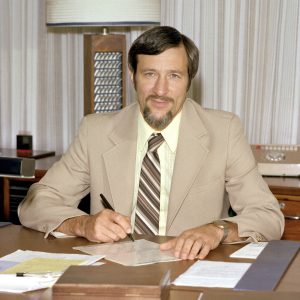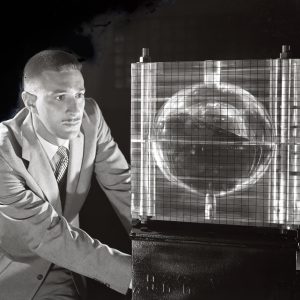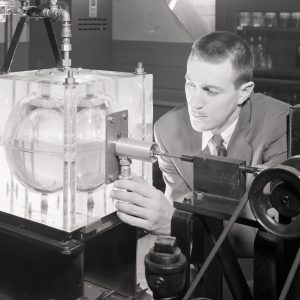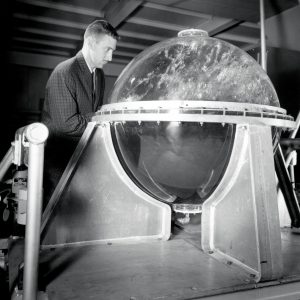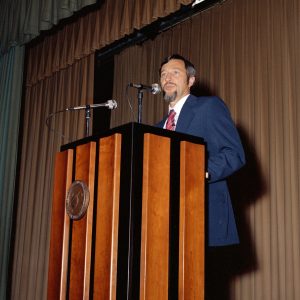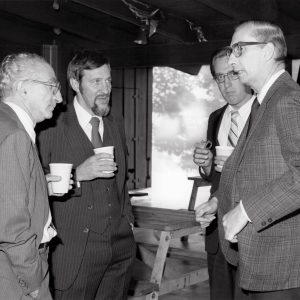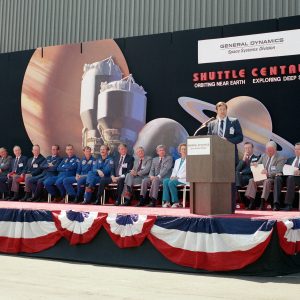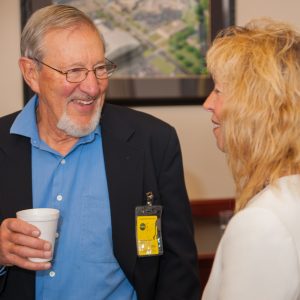Andrew J. Stofan
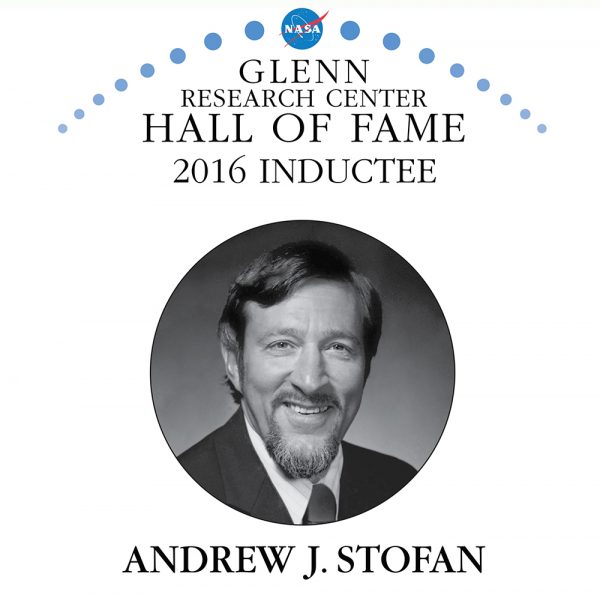
Biography
Andrew (Andy) Stofan made significant contributions to the center and agency in three distinct capacities—researcher, program manager and center director. His propellant management work in the 1960s was important to the success of the Centaur rocket. His management of the demanding and complex Titan/Centaur Program and the larger Launch Vehicles Division produced some of NASA’s biggest successes of the 1970s. Perhaps most significantly, as its center director in the early 1980s, Stofan resurrected the demoralized center by acquiring several new high-profile programs and implementing his trademark inclusive management style.
Stofan earned his bachelor’s degree in math and physics at Hiram College in 1957, and a Bachelor of Science from Carnegie Mellon University in 1958. He joined the Lewis laboratory in 1958, just months before it became part of the new NASA space agency. As a research engineer in the Propulsion Aerodynamics Division, Stofan studied ejector nozzles for supersonic aircraft. Ejector nozzles, which accelerate thrust, were a key component of the Lockheed SR–71, which was under development at the time. Stofan’s research focused on ejectors with variable divergent shrouds.
As part of NASA, Lewis shifted nearly all of its resources to space-related research. In 1960 Stofan became a member of the new Rocket and Aerodynamics Divisions’ Chemical Rocket Systems Branch. There he studied the phenomenon of fluid sloshing inside propellant tanks. Sloshing could be caused by adjustments in the vehicle’s control system, launch vibrations and coasting in space. It was essential to understand and mitigate these occurrences so that the fuel remained in the proper position to be pumped out to the engine.
In 1962 Lewis was assigned responsibility for the Atlas/Centaur rocket. Centaur was the first liquid-hydrogen space vehicle. As part of the Centaur Office’s Propellant Systems Section, Stofan played a key role in developing internal baffles to control propellant sloshing and helped to develop Centaur’s propellant utilization system. This included new gauges to measure the boiling cryogenic propellants and a propellant utilization system that guaranteed that both the propellant and the oxidizer would run out at exactly the same time—an unprecedented advance. In 1966 Centaur completed its first mission—sending a Surveyor spacecraft to the surface of the Moon.
Stofan was named head of the Propellant Systems Section in 1966. He and his colleagues resolved issues regarding the handling of the fluid propellant in microgravity, which had applications not only for Centaur but also for the Saturn upper stages. Stofan also served as project manager for an investigation of Centaur’s boost pumps. The boost pumps increased the propellant’s pressure as it traveled from the tanks to the turbopumps, but they also increased the complexity and cost of the vehicle. Testing of the propellant feed system and of the entire stage at Plum Brook Station [today, the Neil Armstrong Test Facility] revealed that the boost pumps were not necessary. They were subsequently removed from the design.
It is important to note, that even as a young manager, Stofan stressed the need for collaboration and inclusion in decision making. He continued to cultivate this participative management style as he rose through the managerial ranks, and ultimately used it to transform the entire center in the 1980s.
In 1969 Stofan became Assistant Project Manager for the Improved Centaur Program. This was an effort to update the Centaur vehicle design and integrate it with a larger booster, the Titan. The following year, Stofan was tapped to head the Titan/Centaur Program Office. NASA was relying on Titan/Centaur for several “can’t-fail” missions in the 1970s, including sending the twin Viking landers to Mars and two Voyager spacecraft to the outer solar system. Stofan oversaw all the Titan/Centaur work, including addressing the technical complexities of the new vehicle, testing a new hybrid shroud and managing the proof flight test in February 1974.
In 1974 Stofan was promoted to director of the Launch Vehicles Directorate, where he managed the Titan/Centaur and Atlas/Centaur offices, the vehicle design, and systems engineering; and coordinated the Lewis efforts with the Air Force, aerospace industry teams, and mission planners. It was a very hectic period with an unforgiving schedule, but during 1974 to 1978 Stofan’s group successfully completed 10 Atlas/Centaur and 6 Titan/Centaur launches, including the Viking and Voyager missions.
With the end of the Titan/Centaur missions in 1978, Stofan left Lewis to accept the position of Deputy Associate Administrator for the Office of Space Science at NASA Headquarters. Administrator James Beggs referred to him at the time as “a rising star.” Two years later he was appointed Acting Associate Administrator for Space Science. In these positions Stofan managed all of NASA’s space science programs to be conducted on the ground, from the atmosphere, and in space.
Stofan returned to Cleveland in June of 1982 to serve as Lewis’ center director. Despite the success of the Launch Vehicles Directorate, the center had suffered from budget cutbacks, facility closures and downsizing throughout the 1970s. This had resulted in a lack of focus and low morale for the staff, as well as an external perception that the center was not producing any tangible benefits. In fact, Congress had nearly closed down the center just prior to Stofan’s arrival. He later recalled, “I needed a challenge and Lewis was a challenge. It was in trouble. It was in real trouble here. Moral was bad. So when I came back in this was the type of thing that I love.”
Stofan enthusiastically sought to rebuild the center through long-term strategic planning and the implementation of his participative management philosophy. To accomplish the latter, he strove to include as many of the center’s managers as possible in the decision-making process—ending an inherited culture of autocratic management. Stofan had a genuine interest in the ideas of his staff and often refused to give his opinion on an issue so as to not influence their decisions.
Stofan and his colleagues spent six months identifying center-specific goals that aligned with anticipated agency and industry needs. In December 1982 Lewis issued its first strategic plan. It included proposals to obtain several significant aeronautic and space programs—including the high-profile Shuttle-Centaur and the Space Station power system. A former center director referred to the plan as “a remarkable menu of opportunities that tapped into resources all across Lewis and led to major undertakings.”
Lewis then successfully endeavored to acquire each of the desired opportunities. Stofan’s leadership restored center morale, led to the first new hires in years, and put Lewis back in the agency’s mainstream. The mid-1980s through early 1990s proved to be Lewis’ most successful period since the 1960s and included many of the center’s most renowned programs.
In August 1986 Stofan returned to Washington, DC, to serve as associate administrator for the Space Station Office. The president announced the approval of a space station in early 1984, but NASA was struggling to define the design parameters. Stofan reorganized the effort, established a new Space Station Program Office, and issued a number of key design contracts. He successfully guided the program through a very difficult review period with Congress and led a major cost review that led to a new two-phase plan.
Stofan retired from NASA in 1988 with 30 years of service. Afterward, he worked for Martin Marietta Astronautics as vice president of Advanced Launch Systems and of Technical Operations. In 1991 Stofan became president of Analex Corporation in Cleveland. The company, which was established and run by retired NASA employees, provided engineering and management services for Lewis. Stofan subsequently served as director of Electro-Optical Systems at Lockheed Missiles and Space Company.
Stofan’s many awards include the NASA Exceptional Service Medal in 1975, NASA Distinguished Service Award in 1981, the Presidential Rank of Meritorious Executive in 1982, and the Presidential Rank Award of Distinguished Executive in 1985.
Stofan had a legendary career with many highlights. His cryogenic fluid management work was significant to the 1960s space program, his management of the launch vehicles efforts led to major NASA successes in the 1970s, and his management of NASA’s space science and space station efforts impacted the agency. Stofan, however, considers his four years as center director his most important. In that role, he not only provided the hope that was needed to carry on, but empowered staff with the confidence needed to create their own successful destiny. His generous mentoring, cooperative management approach, and leadership style empowered the staff to not only have a vision but to motivate everyone to contribute to the vision. Beyond his adept management skills, it was this “can-do” attitude, confidence, and ability to build relationships that really made him a leader. In addition, a generation of younger managers incorporated Stofan’s managerial philosophy and skills into their work. The center is still feeling the effects of Stofan’s legacy today.
Documents
- Andrew J. Stofan Historical Biography
- Andy Stofan Biographical Sketch (1984)
- Stofan NASA Glenn Biography (2023)
- Anatomy of an Organizational Change (1988)
- Stofan Newsletter Articles (1959-78)
- Stofan Newsletter Articles (1982-86)
- Stofan Newsletter Articles (1986-2014)
- Stofan’s Human Element Speech (1986)

